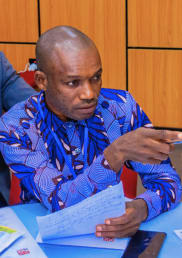Creating a safe, calm, and neutral environment: a step on the path to inclusive peacebuilding in Syria
This week saw presidential elections in Syria. The outcome of a decisive victory of the incumbent president Bashar al-Assad was no surprise.

Assad stood against two heavily vetted candidates who had no history of serious opposition activities. They were pre-approved by 35 members of the Syrian Parliament and had lived continuously in Syria for the last ten years. Displaced citizens living outside of government-controlled areas were excluded from voting, with the opposition and Syrian Democratic Forces instituting a de facto boycott of the election in the areas under their control. Syrian expatriates could only vote in person at the Syrian embassy in their country of residence (where an embassy was open).
The elections have been widely rejected by the Syrian opposition, western states and some Arab states as illegitimate and as being neither free nor fair. A statement issued by the foreign ministers of France, Germany, Italy, the United Kingdom and the United States of America, highlighted that for an “election to be credible, all Syrians should be allowed to participate, including internally displaced Syrians, refugees, and members of the diaspora, in a safe and neutral environment.”
The presence of a safe, calm, and neutral environment is a main condition that the UN has declared for holding elections in the country under the supervision of the United Nations in line with the Security Council Resolution 2254. It is clear that this condition has not been met for all Syrian citizens.
At this point the outlook for the country is a continued de facto separation of territory into three main zones with the Russia and Iran-backed Assad regime controlling 60% of the territory, the US-backed Syrian Democratic Forces controlling 30% of the territory, and the Turkey-back Syrian National Army controlling the remaining 10% of the country. The conflict has evolved into a frozen conflict where there is a decrease in violence overall, but no real peace and each area has its own political, economic and governance structures.
Although marred with setbacks, efforts continue under the auspices of the UN towards a negotiated political settlement, permanent ceasefire, and path to inclusive peace. The citizens of Syria – both inside Syria and outside the country – have the right to live in safety now and in the future. The idea of a safe, calm and neutral environment must not be left as a concept and rhetorical standard. Steps to create these conditions in reality are urgently needed.
Definitions, parameters, and metrics for measuring safe, calm, and neutral must be put in place. ‘Safety’ implies being free from harm or risk now and in the future and can be judged by, for example, the number of attacks that take place and the numbers of those killed. ‘Calm’ can be judged by monitoring things such as IDP movements. Neutrality pertains to attitudes of third parties and is reflected in parameters such as impartial treatment of citizens and fair access to aid and resources.
The standard of safe, calm and neutral is also arguably a critical standard to meet for the return of IDPS and refugees. The Danish government recently declared that it would revoke residency permits of some Syrians based on its assessment that the Syrian capital Damascus and the governorate surrounding it are “no longer dangerous”. Denmark has no diplomatic relations with Syria so would not be actively deporting Syrians back to Syria, but the revocation of permits does strip refugees of the right to work and education and means that they will be forced into deportation centres for an indefinite period.
Dana, a Syrian refugee from Homs who is now living in Denmark, told us that she fears that the move will affect all Syrians refugees, regardless of how long they have been in Denmark or where in Syria they are originally from.
The conditions inside Syria and the shifting policies towards refugees in some host countries, such as Denmark, underline the urgency of defining and setting standards and parameters for a safe, calm, and neutral environment. It is not just about the number of bombs that are falling, but about whether individual rights and freedoms will be respected and protected – something that currently cannot be guaranteed for all Syrians.
To realise the required conditions for a safe, calm and neutral environment, action must be taken by critical actors the US and Turkey, with the involvement of Russia and an active role being consigned for the UN. Further fundamental steps entail the placing of Syrian citizens at the heart of the process, along with the inclusion of civil society in shaping a human-centred approach to security. It is incumbent on the states that are hosting refugees to abide by the standards of safe, dignified and durable return – a long standing core tenet of the international refugee regime.
The definition of a safe, calm, and neutral environment and taking steps to achieve it, has the potential to contribute to enabling an inclusive political process which reflects the diversity of Syrian identities, peace values, justice, and the participation of civil society in building peace in Syria.



